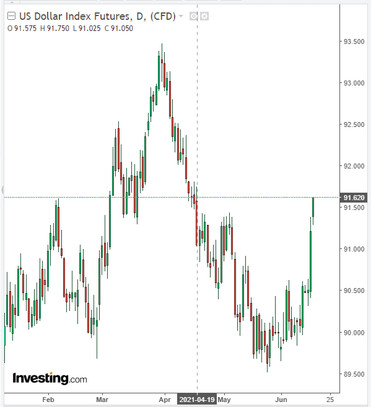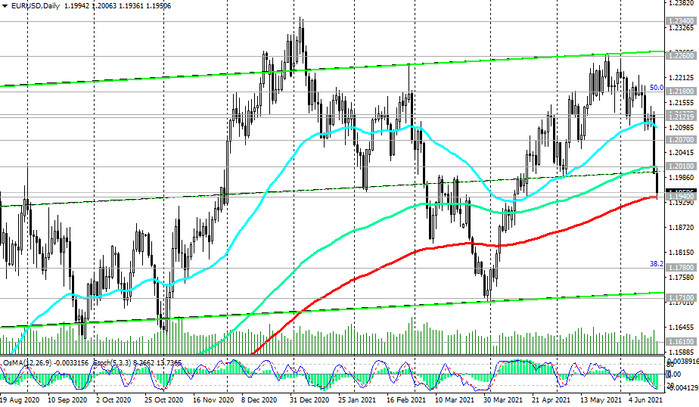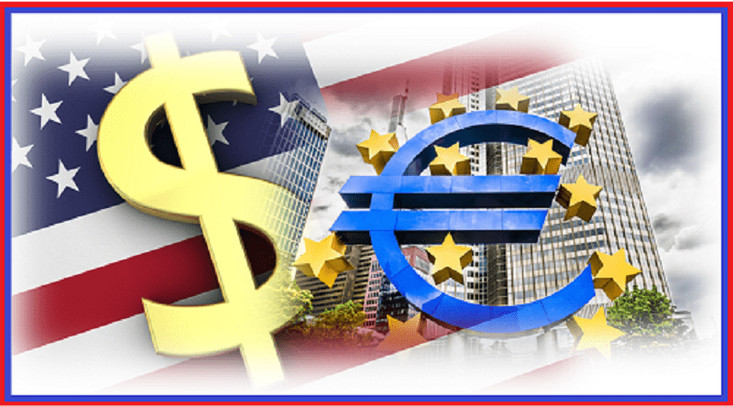Despite the decline in government bond yields, the US dollar continued to strengthen during today's Asian session. The DXY dollar index also continues to rise in early European session today, while the yield on US 10-year bonds declined to 1.570% from yesterday's high of 1.594%. As of this writing, DXY futures are traded near 91.62 mark, 114 pips above yesterday's opening price, ahead of the Fed's interest rate decision. Thus, the DXY dollar index returned to the levels of 2 months ago.

As you know, following the results of the 2-day meeting on monetary policy, the Fed leaders kept key interest rates in the range of 0.00%-0.25%, and the volume of the QE asset purchase program remained at the same level of $ 120 billion per month.
The accompanying statement said that the Fed will continue to adhere to the current parameters of monetary policy until the target levels for inflation and maximum employment are reached, reiterating that the level of interest rates will not change.
However, the Fed is now forecasting two rate hikes in 2023, whereas earlier central bank officials had pledged not to raise rates until the end of 2023.
13 of the 18 central bank governors said they expected short-term interest rates to rise by the end of 2023, compared with only 7 in March. Already 7 representatives of the FOMC against 4 in March expect the start of rate hikes already in 2022.
At the same time, the chairman of the US Federal Reserve System Jerome Powell at a press conference following the meeting of the Committee on Open Market Operations on Wednesday did not say when the curtailment of asset purchases may begin, repeating that the Fed will warn about any changes in advance. "The timing, of course ... will depend on the degree of our progress, and not on any calendar", he said.
In his opinion, inflation may be higher and more stable than expected, and to solve this problem, the Fed uses monetary policy instruments.
Central bank officials want to get the economy closer to" maximum employment " and sustained annual inflation of 2.0% before scaling back asset purchases. According to them, these goals must be achieved before the regulator moves to raise rates.
From this point of view, it is worth paying attention to the publication today at 12:30 (GMT) of the weekly data from the US labor market. It is expected that the number of initial claims for unemployment benefits fell in the last reporting week to 359,000 from 376,000 a week earlier. This is a positive factor for the dollar. However, since the previous meeting in April, the improvement in the labor market situation has slowed slightly compared to the Fed's expectations, and the total number of jobs in the country is still 7.6 million below pre-coronavirus levels.
This will deter the Fed's leadership from earlier raising rates. Nevertheless, the rhetoric of statements from the FRS leadership alerted market participants, betting on further weakening of the dollar.
The reason for the change in the approach to monetary policy is the stronger economic recovery and faster inflation compared to the Fed's forecasts presented a few months ago. "Progress in vaccinations is holding back the spread of the coronavirus in the United States", the Fed said in a statement. "Amid this progress and strong (monetary) support measures, economic activity and employment have become stronger".
The dollar strengthened sharply following the Fed meeting, while the main rival of the euro fell in tandem with the dollar. At the time of this posting, EUR / USD is traded near 1.1950 mark, just above the key long-term support level 1.1940 (see Technical Analysis and Trading Recommendations), which also corresponds to the low of the last 9 weeks.
According to economists, the situation in the European labor market may worsen when government assistance programs are phased out. This will contain wage growth in 2021 and 2022 and could ease inflationary pressures in the Eurozone, which have intensified in recent months due to the opening of the economy and supply problems. No sustained rise in price pressures is expected in the Eurozone over the medium term, economists say, and the ECB remains cautious, according to the results of last week's meeting. Thus, it is becoming increasingly difficult for the EUR / USD pair to develop a stable upward movement, and the breakdown of the long-term support levels 1.1940, 1.1880 may increase the risks of breaking the bullish trend, and the breakdown of the support level 1.1610 will finally "put an end to it".






